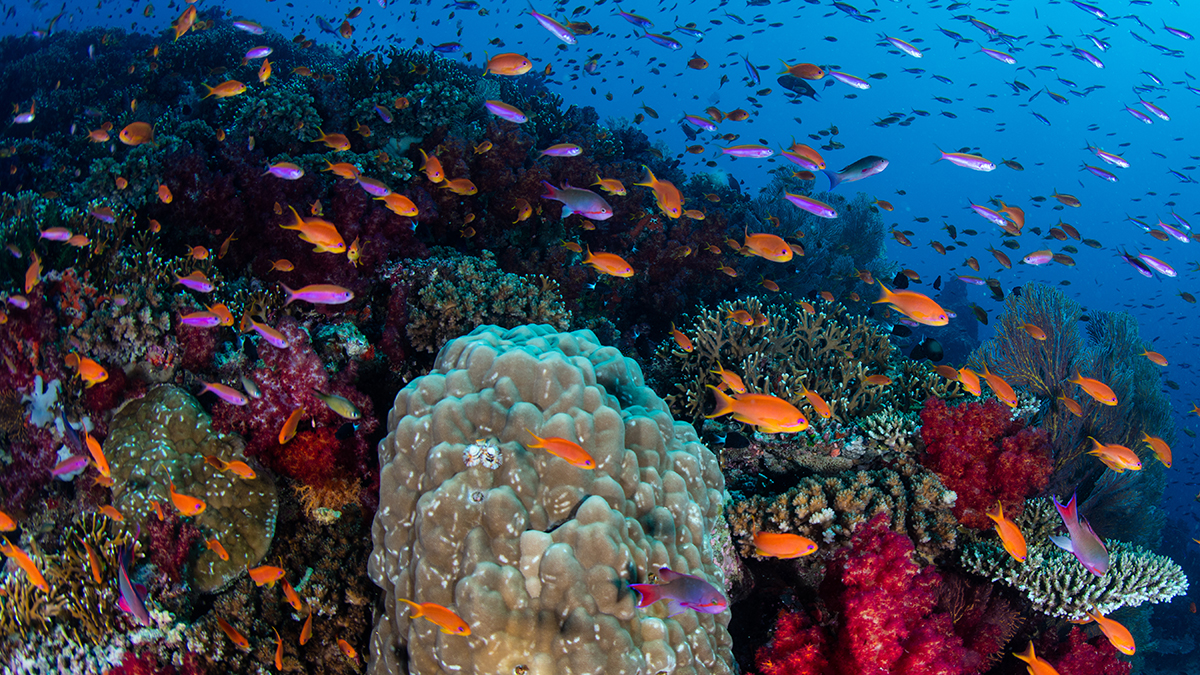feature
What's the Big Deal About Ocean Acidification?
Fifth-grade students from an inland community discover a local connection to our ocean
We have only one ocean and it is inextricably linked to human health, yet research shows most elementary students do not understand the one-ocean concept (Mogias 2019). Additionally, the ocean—and its problems—may seem unrelated to students’ lives even though it provides half of the oxygen we breathe (via plankton); manufactures our weather; supplies food and drinking water; and makes a global economy possible. “Enhancing interactions with the ocean through experiential learning could be the most effective way of improving ocean literacy as well as marine citizen- and stewardship” (Guest et al. 2015). So, we—a literacy consultant and a children’s author—came together to show educators how STEM and language arts could be combined in ocean experiential learning.
In a series of 12 project-based learning lessons, a group of seven fifth-grade students who live 200 miles from the coast explored their personal connections to our ocean. After completing a unit on the role of water in Earth’s surface processes, the students investigated ocean acidification and how this pervasive ocean problem impacts their local community. We had three basic goals for our students:
- Learn the process of ocean acidification and its impact on the environment.
- Understand the link between their inland community and the ocean.
- Form meaningful emotional relationships with the ocean and take action on ocean sustainability.
The following lessons may be scaled up for an entire class. For example, the teacher could work with a rotation of small groups while other students work collaboratively on related tasks. Alternatively, the teacher could provide whole-group focus lessons (or, in some cases, directions) and then confer with small groups as they engage in the conversations and other activities described here.
Engage: Planet Ocean?
We began by engaging students with the ocean to help them develop a fascination with the underwater world. Students received digital access to Planet Ocean: Why We All Need a Healthy Ocean (Newman 2021) and were asked to read independently to obtain and evaluate information by examining the layout, design, narrative, and features including QR codes that link to short helpful videos. We then asked students to think about important points and communicate to classmates why these points were important. While Planet Ocean received a Lexile score of 1030, typically for grades 4 to 6, the book includes different writing and design formats that make the text easier for some learners to comprehend, including narratives about the work of climate activists, detailed photographs, links to videos that support understanding, and diagrams. To meet the needs of diverse groups of students or students with special needs, the teacher might assign specific sections of text or videos instead of the book as a whole, or confer with individuals or small groups as they read more complex parts.
To prepare the group for student-led discussions about what they read, we modeled for students how to prepare for a conversation with their peers. After reading from a short section of the book, Sunday Cummins “thought aloud” about what details she wanted to remember to share while writing a few thoughts on a sticky note. The students followed a similar process, and then shared in small groups.
Explore: What Is Acidification?
During the second lesson, students explored an entirely new concept to them—ocean acidification, a key problem addressed in Planet Ocean. Small groups received a “puzzle” with parts of a diagram they had to assemble and make sense of (Figure 1). The following questions were posted for students to discuss as they engaged in this experience:
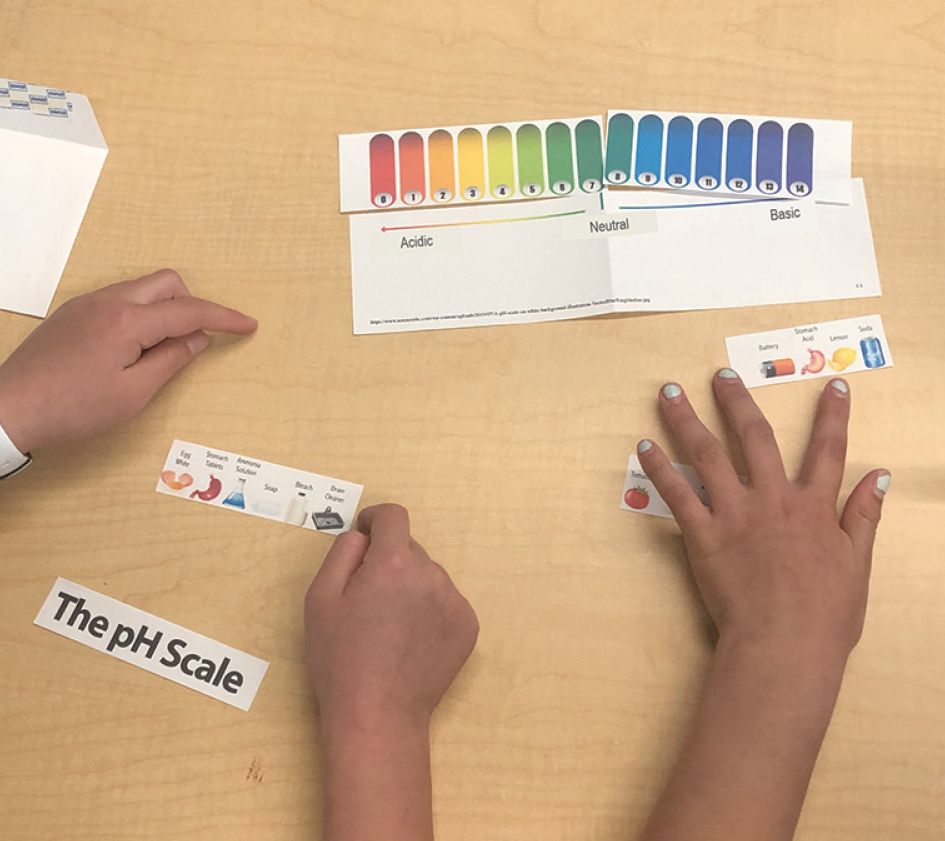
Students assemble a pH scale puzzle.
- What do you notice in the diagram?
- What do you think pH scale means?
- Why might it be important?
In her small group, Emma (pseudonyms used throughout) shared, “It’s about what’s good and bad for us.” But then Zahra noticed that an image of a lemon was on the acidic end of the scale with a battery and stomach acid. “Lemons aren’t bad for you, right?” she asked. We nudged the group’s thinking by saying, “When you say good and bad, it sounds like you are measuring something. Could that be what this is about?” They nodded, noting the words acidic and basic, surmising that the pH scale must measure these concepts in some way. Mia pointed out that water and blood are near the middle of the scale, and we responded with, “So what might happen if the measurement of acidity changed in our blood or in the water?” The students concluded that the scale may also reveal what the pH needs to be consistently for each of the items pictured.
In the next activity, students (wearing chemical-splash safety goggles) were presented with three jars of red cabbage juice containing high levels of a pH-sensitive pigment called anthocyanin. As the pH of the pigment declines, it gradually turns from dark blue to pink.
When a student squeezed lemon juice into the first jar, there was an audible gasp. They saw the cabbage water change from blue to pink. They looked back at the diagram they had assembled and noticed that the lemon was on the acidic end of the scale, so they concluded that the water was now acidic.
Next, the teacher blew through a straw into the second jar, and the students jumped up and down with excitement as the water turned slightly pink (Figure 2). “It’s becoming more acidic!” someone shouted. Students saw the cause-effect crosscutting concept in action. We set aside the third jar as the control.
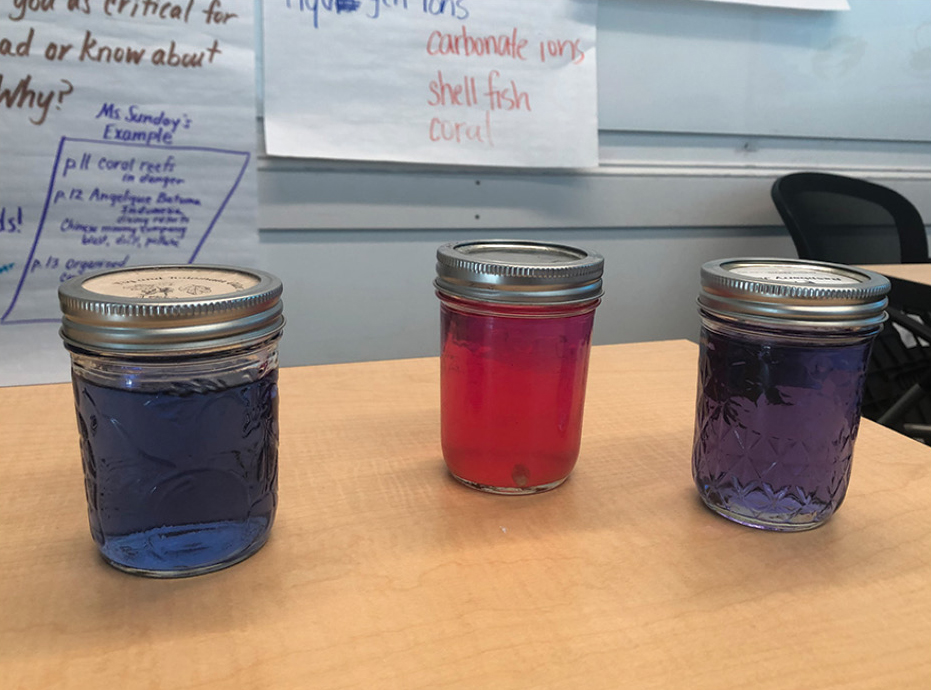
Cabbage water in jars.
Explain: How Would You Explain This Problem?
Students needed help explaining the chemistry behind ocean acidification in their own words. In pursuit of this goal, they studied the following excerpt from Planet Ocean:
When carbon dioxide dissolves in seawater, a chemical reaction called ocean acidification takes place. Water and carbon dioxide combine and form an acid. The acid immediately releases hydrogen ions, particles that race through the water searching for carbonate ion—the very same stuff corals need to grow. (Newman 2021, p. 15)
Although the excerpt uses the word ion, we did not focus on the atomic level organization of matter, but rather the why and how of ocean acidification. After an initial reading of the excerpt, students engaged in a close reading, pausing at the end of each sentence to ask, “What did I just learn?” and “What are key details I want to remember?” We recorded the keywords or phrases they identified on chart paper. Next, they watched a short video on ocean acidification (see Online Resources) before returning to their keyword list, adding and adjusting as they consolidated their learning. The key words served as “triggers” for remembering this complex process and as “scaffolds” when the students needed support in explaining their learning.
To assess students’ learning, we challenged small groups to draw diagrams of what happens during ocean acidification (Figure 3), then evaluated the diagrams and provided feedback on sticky notes for revisions.
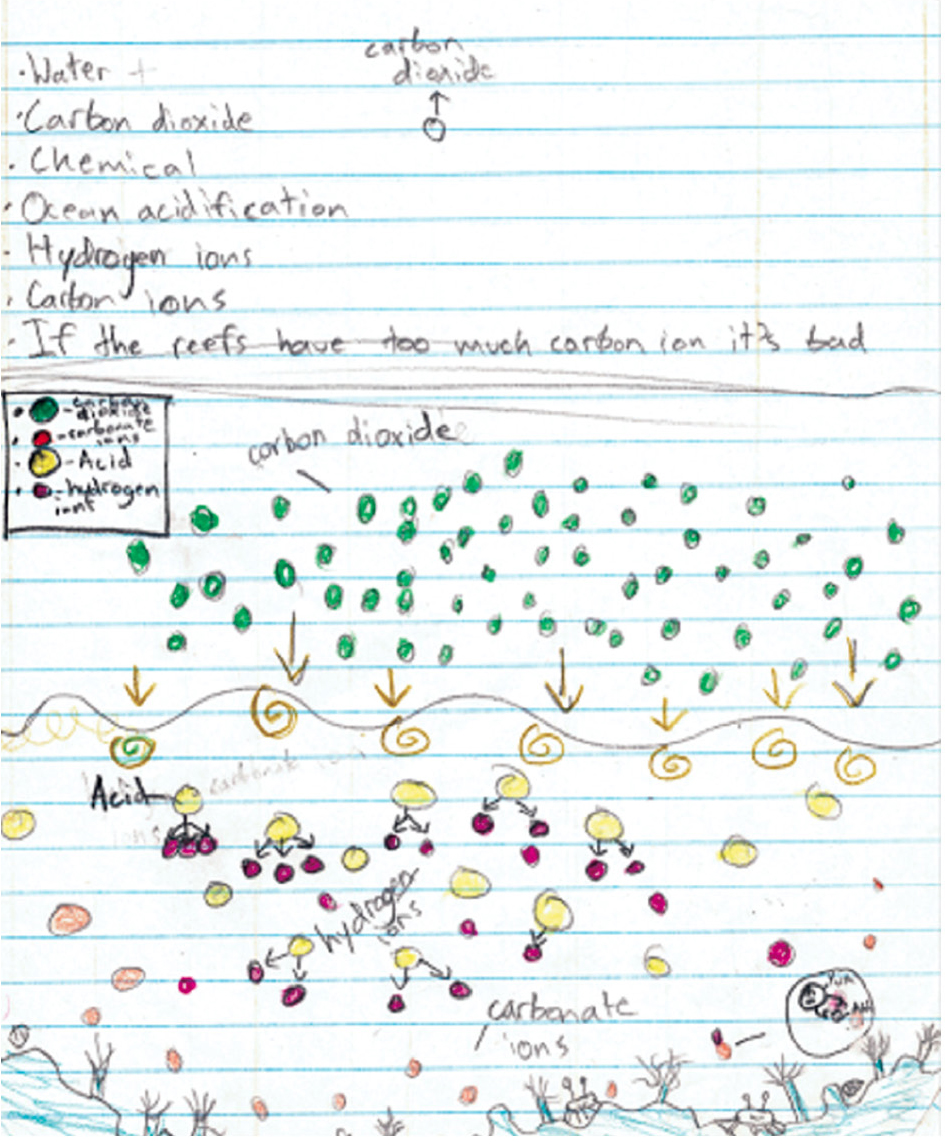
Student-friendly ocean acidification diagrams.
Elaboration: Why Is This an Issue?
Research shows that we are usually far removed from life-sustaining systems. If we understand our local bioregions, we can learn how ecosystems support life (Pyle 2008). So, we helped our students make a personal connection to the ocean through salmon in a local river.
Students learned that Chinook salmon spawn in a river in their community and are a source of food, jobs, and local tourism. To capture students’ interest in how the health of the ocean is connected to their community, we asked students to revisit the sections of Planet Ocean (Newman 2021, pp. 27–30) that mention salmon. Student-led groups assigned sections for rereading and then discussed their learning. They realized the health of salmon is not only important to their community but also to the Lummi Nation in the Pacific Northwest whose cultural identity depends on salmon. The reading also emphasized salmon as a worldwide food source and an industry that supports many jobs. With their newfound understanding of ocean acidification, students became alarmed when they read that a juvenile salmon’s “sense of smell goes haywire” (Newman 2021, p. 27) when exposed to acidified water in laboratory experiments.
The students dove into independent research about the life cycle of salmon. Then as a group they conducted a Zoom interview with a local environmental scientist with the state’s department of water resources who confirmed their suspicions. Like the salmon fishermen of the Lummi Nation, students discovered that mature Chinook salmon from their local river are returning in fewer numbers. They are also returning at earlier ages, which means they weigh less, again mirroring the Lummi Nation’s experience. The scientist indicated that the health of the ocean is probably one of the reasons for these changes. It might be interesting to ask your students if their families fish for a living and ask for anecdotal information about fish size. Additional research revealed that when adult salmon die, their carcasses become nutrients for the river and many land-dwelling creatures. Even trees absorb nutrients from salmon. Bears carry the carcasses into the forest and the remains are absorbed by the soil of the many trails students regularly hiked with their families. The interconnectedness of the ocean and all living things was clear for the students. Like the Lummi Nation, their local forests, animals, and community depend on salmon, too.
Evaluate: “So How Do You Share What You Learned?”
Helping our students connect the health of the ocean to the health of their community was a key goal of this unit. At this school, fifth-grade students produce a regular newscast. Our seven students decided to create a video story for the newscast to show classmates the cause-and-effect relationship between fossil fuels and the health of local salmon, and to show their classmates how they can help.
In preparation, the students interviewed Patricia Newman, author of Planet Ocean, via Zoom for advice (Figure 4). They watched a short QR code video from Planet Ocean and analyzed the narrator’s tone and style. They developed a “whiz bang intro,” assembled supporting details that explained how carbon pollution (cause) changed the ocean (effect), and designed a “call to action” that left their audience with “hope.” The students read scripts they wrote for the voice-over narration and collected relevant photographs from reliable sources on the internet (with permission) to illustrate their story. The students planned out the scenes, assigned parts, and assembled those parts (scripts, photos, links) into a shared Google doc. They met in pairs to read aloud and revise for accuracy and coherence; they met as a larger group to rehearse and make sure there was cohesion across the parts. Although we assembled the final video in the interest of time, students could use video editing software to complete this step.
Pathways for Making Meaning and Revealing Learning
We used experiential learning to improve the students’ ocean literacy and sense of stewardship. As a result, the lessons in this unit provided several avenues for students to make meaning or acquire knowledge. In addition to reading Planet Ocean, each student read or viewed various self-selected sources and determined the types of notes they would take for various tasks. They engaged in numerous meaning-building conversations that required them to integrate new vocabulary and content with intention. They had opportunities to evolve their own thinking during hands-on experiments and to synthesize their learning through diagrams, writing, and rehearsing and producing a video.
While the final video reveals accumulated group learning, their process—the ocean acidification investigations and diagrams, the writing, the one-to-one conferences with us for their particular part of the scripts, and the student-to-student conversations on revising and editing—revealed the depth of knowledge they developed. While not used in this project, a simple rubric for evaluating learning could be used as a guide for students and to justify grades given to each student.
Takeaways
“Interdisciplinary education results in an increase in higher level thinking skills, which impact the development of personal ethics” (Burgess and Johannessen 2010). Teaching a unit of study like this can help our students develop relevant personal connections and commitments to global issues. This is the kind of learning that sticks as revealed in the last part of the script that Zahra wrote for the video:
“But something that will help our cause above all else is learning about the problem and using your voice. Spread awareness to others about the problem. Give them hope for what Planet Ocean could be if they do their part.... We may be the problem, but if we work together, we will be the solution.”
While not every community has Chinook salmon in a nearby river, we’re all connected to the ocean in some way. People work in jobs connected to the ocean. People enjoy hiking in nature that may have absorbed nutrients from creatures that live in the ocean. Many watersheds are connected to the ocean. By discovering value in the natural world, we “encourage the exploration of what we believe and who we are and how we intend to live in the world” (Burgess and Johannessen 2010). In this era of climate change, students must recognize our one ocean and our connection to its health. The use of project- and place-based learning allows students to experience the impact of our actions on the environment; discover a link between their communities and the ocean; and form a meaningful emotional relationship with the ocean that empowers them to take action on sustainability. ●
The authors would like to thank fifth-grade teachers Kelli Voss and Jennifer Cox; Jason Kindopp, Senior Environmental Scientist for the California’s Department of Water Resources; and Washington Sea Grant.
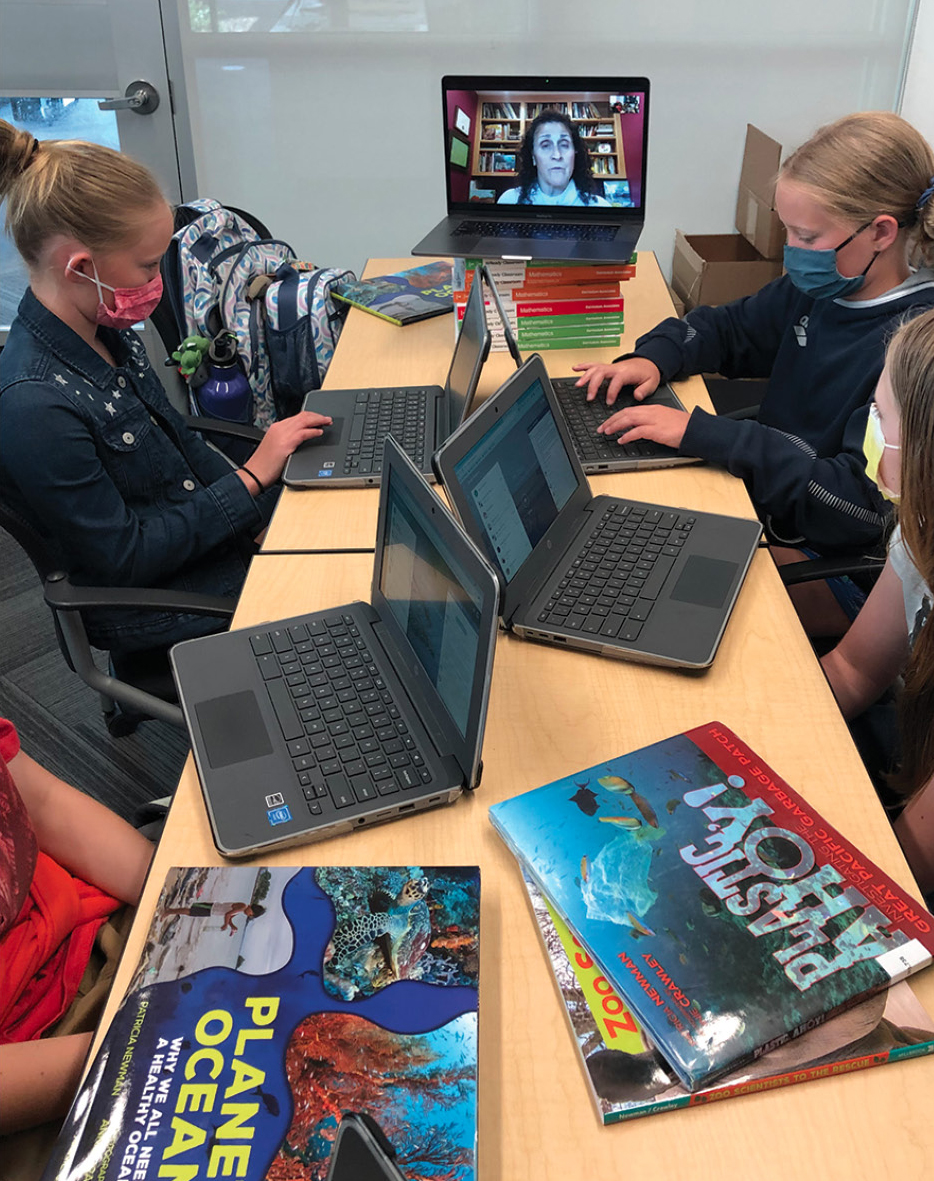
Students interview Planet Ocean author Patricia Newman via Zoom.
Online Resources
What is Ocean Acidification? By Alliance for Climate Education: 1:07–1:30. https://www.youtube.com/watch?v=6SMWGV-DBnk
“Phenomenon: What is ocean acidification?” Planet Ocean curriculum guide 2021, pp. 5–6. https://bit.ly/3hVb3dp
Sunday Cummins (https://www.sunday-cummins.com) is a literacy consultant and author in Chico, California. Patricia Newman (https://www.patriciamnewman.com) is a children’s author and speaker in Carmichael, California.
Biology Earth & Space Science Instructional Materials Interdisciplinary Labs Teaching Strategies Three-Dimensional Learning Elementary



